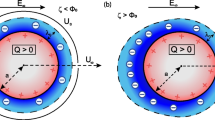Abstract
Electrophoretic separation of a mixture of chemical species is a fundamental technique of great usefulness in biology, health care, and forensics. In capillary electrophoresis, the sample migrates in a microcapillary in the presence of a background electrolyte. When the ionic concentration of the sample is sufficiently high, the signal is known to exhibit features reminiscent of nonlinear waves including sharp concentration “shocks.” In this paper, we consider a simplified model consisting of a single sample ion and a background electrolyte consisting of a single coion and a counterion in the absence of any processes that might change the ionization states of the constituents. If the ionic diffusivities are assumed to be the same for all constituents the concentration of sample ion is shown to obey a one dimensional advection diffusion equation with a concentration dependent advection velocity. If the analyte concentration is sufficiently low in a suitable nondimensional sense, Burgers’ equation is recovered, and thus the time dependent problem is exactly solvable with arbitrary initial conditions. In the case of small diffusivity, either a leading edge or trailing edge shock is formed depending on the electrophoretic mobility of the sample ion relative to the background ions. Analytical formulas are presented for the shape, width, and migration velocity of the sample peak and it is shown that axial dispersion at long times may be characterized by an effective diffusivity that is exactly calculated. These results are consistent with known observations from physical and numerical simulation experiments.
Similar content being viewed by others
References
Avrin, J.D., 1988. Global existence for a model of electrophoretic separation. SIAM J. Math. Anal. 19(3), 520–527.
Babskii, V., Zhukov, M., Yudovich, V., 1989. Mathematical Theory of Electrophoresis. Plenum, New York.
Boušková, E., Presutti, C., Gebauer, P., Fanali, S., Beckers, J., Boček, P., 2004. Experimental assessment of electromigration properties of background electrolytes in capillary zone electrophoresis. Electrophoresis 25, 355–359.
Bullock, J., Strasters, J., Snider, J., 1995. Effect of multiple electrolyte buffers on peak symmetry, resolution, and sensitivity in capillary electrophoresis. Anal. Chem. 67, 3246–3252.
Camilleri, P. (Ed.), 1998. Capillary Electrophoresis, Theory & Practice. CRC Press, Boca Raton.
Desiderio, C., Fanali, S., Gebauer, P., Boček, P., 1997. System peaks in capillary zone electrophoresis II. Experimental study of vacancy peaks. J. Chromatogr. A 772, 81–89.
Erny, G., Bergstrŏm, E., Goodall, D., 2001. Predicting peak shape in capillary electrophoresis: a generic approach to parametrizing peaks using the Haarhoff–Van Der Linde (NVL) function. Anal. Chem. 73, 4862–4872.
Erny, G., Bergstrŏm, E., Goodall, D., 2002. Electromigration dispersion in capillary zone electrophoresis experimental validation of use of the Haarhoff–Van Der Linde function. J. Chromatogr. A 959, 229–239.
Fife, P.C., 1988. Dynamics of Internal Layers and Diffusive Interfaces. SIAM, Philadelphia.
Fife, P.C., Palusinski, O.A., Su, Y., 1988. Electrophoretic traveling waves. Trans. AMS 310(2), 759–780.
Gaš, B., 2009. Theory of electrophoresis: Fate of one equation. Electrophoresis 30, S7–S15.
Gebauer, P., Boček, P., 1997. System peaks in capillary zone electrophoresis I. Simple model of vacancy electrophoresis. J. Chromatogr. A 772, 73–79.
Ghosal, S., 2006. Electrokinetic flow and dispersion in capillary electrophoresis. Annu. Rev. Fluid Mech. 38, 309–338.
Hickman, H., 1970. The liquid junction potential—the free diffusion junction. Chem. Eng. Sci. 25, 381–398.
Horká, M., Šlais, K., 2000. Low-conductivity background electrolytes in capillary zone electrophoresis—myth or reality? Electrophoresis 21, 2814–2827.
Kohlrausch, F., 1897. Ueber Concentrations-Verschiebungen durch Electrolyse im inneren von Lösungen und Lösungsgemischen. Ann. Phys. 62, 209–239.
Landers, J. (Ed.), 1996. Introduction to Capillary Electrophoresis. CRC Press, Boca Raton.
Mikkers, F., 1999. Concentration distributions in capillary electrophoresis: CZE in a spreadsheet. Anal. Chem. 71, 522–533.
Mikkers, F., Everaerts, F., Verheggen, T.P., 1979. Concentration distributions in free zone electrophoresis. J. Chromatogr. 169, 1–10.
Planck, M., 1890. Ueber die Erregung von Electricität und Wärme in Electrolyten. Ann. Phys. Chem. 39, 161–186.
Poppe, H., 1999. System peaks and non-linearity in capillary electrophoresis and high-performance liquid chromatography. J. Chromatogr. A 831, 105–121.
Probstein, R., 1994. Physicochemical Hydrodynamics. Wiley, New York.
Robinson, R., Stokes, R., 2002. Electrolyte Solutions. Dover, Mineola.
Rubinstein, I., 1990. Electro-Diffusion of Ions. SIAM, Philadelphia.
Russel, W., Saville, D., Schowalter, W., 1989. Colloidal Dispersions. Cambridge University Press, Cambridge.
Saville, D.A., Palusinski, O.A., 1986. Theory of electrophoretic separations. Part I: Formulation of a mathematical model. AIChE J. 32(2), 207–214.
Thormann, W., Caslavska, J., Breadmore, M., Mosher, R., 2009. Dynamic computer simulations of electrophoresis: Three decades of active research. Electrophoresis 30, S16–S26.
Weber, H., Riemann, B., 1910. Die partiellen Differential-Gleichungen der mathematischen Physik. Vieweg, Wiesbaden.
Whitham, G., 1974. Linear and Nonlinear Waves. Wiley-Interscience, New York.
Author information
Authors and Affiliations
Corresponding author
Additional information
Supported by the NIH under grant R01EB007596.
Rights and permissions
About this article
Cite this article
Ghosal, S., Chen, Z. Nonlinear Waves in Capillary Electrophoresis. Bull. Math. Biol. 72, 2047–2066 (2010). https://doi.org/10.1007/s11538-010-9527-2
Received:
Accepted:
Published:
Issue Date:
DOI: https://doi.org/10.1007/s11538-010-9527-2




